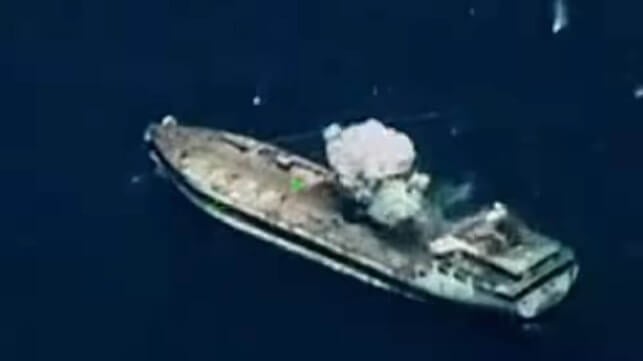Video: Philippine and US Forces Sink Tanker in S. China Sea Exercise

On Wednesday, forces from the U.S., Australia and the Philippines sank a decommissioned product tanker to test out their equipment and targeting techniques. The joint force tried out a range of smaller, less expensive munitions that could be used in quantity on smaller vessels - for example, China's vast coast guard fleet and its maritime militia trawlers, which number in the hundreds. These vessels are the leading players in confrontations between the Philippines and China, and regularly blockade strategic sites in the South China Sea.
The target was the BRP Lake Caliraya, a small tanker decommissioned from government service. It had been in the Philippines for decades, but it was originally built in a Chinese yard. The selection of a Chinese-made ship for the exercise drew protests from Beijing, though Manila insists that the vessel's origin was coincidental.
The trial employed cannons, shore-based artillery and at least four missile systems: C-Star, Spike NLOS, GBU-38 JDAM, and the APKWS rocket system. Of these, only C-Star is a dedicated long-range antiship missile; it is a South Korean design intended as a replacement for the Harpoon, and is in the Philippine inventory. Spike is an Israeli/American designed multipurpose mid-range guided missile, smaller than a conventional antiship missile. The GBU-38 is a 500-pound guided bomb, the smallest version of the U.S. Joint Direct Attack Munition (JDAM); it is not specifically designed for maritime targets, but with typical accuracy in the range of 15 feet, it is capable of striking ships. It can be deployed by virtually any Air Force, Marine Corps or Navy strike aircraft.
The APKWS (advanced precision kill weapons system) is perhaps the most economical and easily-deployable of these options. It fits onto the ubiquitous 2.75 inch Hydra 70 rockets used by American aircraft for close air support, turning them into cheap and highly accurate laser-guided weapons. While their range is limited to a few kilometers, they can be deployed with relative ease and low cost using existing launchers. The U.S. Navy has purchased them for the Seahawk helicopter for a maritime role. (In a separate exercise, the U.S. Air Force's special operations division tested the cannons of an AC-130J Ghostrider gunship on a pair of fishing vessels off the Philippines - adapting another low-cost weapon from the Mideast wars to the challenges of the South China Sea.)

that matters most
Get the latest maritime news delivered to your inbox daily.
The U.S. Army's anti-ship missile platform, the Medium Range Capability (MRC), was deployed to the Philippines with much fanfare for Balikatan 2024. However, it was only used for "virtual and constructive fires" for the sinking exercise, the Pentagon said. The MRC can launch the Tomahawk ground-attack missile and the SM-6 supersonic air defense / antiship missile.
